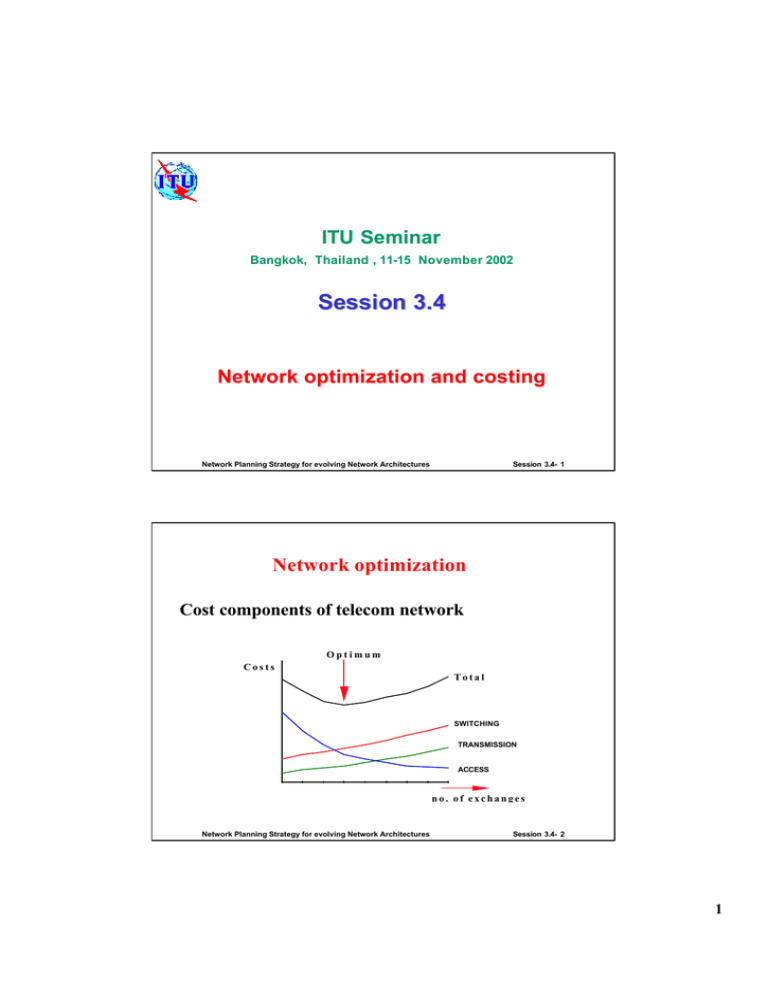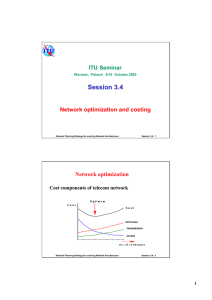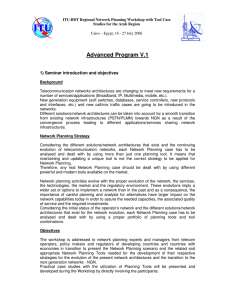Session 3.4 ITU Seminar
advertisement

ITU Seminar Bangkok, Thailand , 11 11--15 November 2002 Session 3.4 Network optimization and costing Network Planning Strategy for evolving Network Architectures Session 3.4- 1 Network optimization Cost components of telecom network Optimum Costs Total SWITCHING Exchanges CTRANSMISSION ircuits SACCESS ubscribers no. of exchanges Network Planning Strategy for evolving Network Architectures Session 3.4- 2 1 Network optimization Optimization task find minimum network cost solution for given (forecasted) demand for services and specified (requirements) quality of service Owing to the complexity and size of the typical telecom network, it is not possible to treat all aspects of the network simultaneously Network Planning Strategy for evolving Network Architectures Session 3.4- 3 Network optimization Iterative procedure for optimizing a telecom network Network optimization problem to be solved has to be divided into a number of suitable sub-problems, these to be treated iteratively in a certain order For the solution of any of these sub-problems, we assume that the rest of the network has been correctly optimized and/or dimensioned Initially, of course, this will not be the case, and the necessary data will then have to be estimated Network Planning Strategy for evolving Network Architectures Session 3.4- 4 2 Network optimization Service/ routing layer Transport layer Network Planning Strategy for evolving Network Architectures Session 3.4- 5 Network optimization Exchange locations Boundaries Circuits Locations Distances Exchange boundaries Locations Cost / erlang Boundaries Subs / exch Inter-exchange traffics Boundaries Subs / exch Traffic distribution Inter-exchange circuits Traffics Cost / circuit Circuits Routing Transmission systems Circuits Distances Cost / link Cost / circuit Current network Improved network Network changes Network Planning Strategy for evolving Network Architectures Session 3.4- 6 3 Network optimization Cost structure : Cost subscriber – exchange: D E ⋅ Cs ( D E ) + C f per subscriber, service Cost exchange – exchange: DEF ⋅ Cc ( DE ) + Cd per circuit, channel (x2 , y2 ) Cost of exchange equipment (including the switch) (x, y) Ly Cost of building, container, etc. (x1 , y 1 ) Lx (XE , Y E ) distance calculation Network Planning Strategy for evolving Network Architectures Session 3.4- 7 Network optimization Cost structure : Total network cost function, C, could be expressed, e.g. in the model with subscriber zones (grid), as C= + NEX NEX E =1 ( i ,j ) ∈E E =1 ∑ ∑ sub( i, j ) ⋅ [Cs ( DE ) ⋅ DE + Cf ] + ∑ [ Ca ( E ) + Cb ( E )] + NEX NEX ∑ ∑ NEF ⋅ [ Cc ( DEF ) ⋅ DEF + Cd ] E =1 F = 1 Network Planning Strategy for evolving Network Architectures Session 3.4- 8 4 Network optimization Cost structure : C= NEX ∑ [ ] NEX ∑sub(i, j )⋅ Cs( DE )⋅ DE +Cf + ∑[Ca ( E)+Cb( E)] + E=1 (i, j )∈E E=1 NEX NEX +∑ ∑NEF ⋅[Cc( DEF )⋅ DEF +Cd ] E=1 F=1 Network Planning Strategy for evolving Network Architectures Session 3.4- 9 Network optimization E.g. theoretically optimal location (XE,YE) has the property that the partial derivatives of the total network cost function, C, with regard to XE and YE are equal to zero : ∂C ∂X E = 0 ∂C ∂YE = 0 . . .NEX for E = 1,2,K Standard condition for continues space – location could be anywhere in the area If not satisfied ( locations could be only in particular places ) – becomes combinatorial problem Network Planning Strategy for evolving Network Architectures Session 3.4- 10 5 Network optimization Model with subscriber nodes - combinatorial problem calculate the total network cost, C, for all combinations (solutions) and find the smallest C = Cmin for n nodes and N equipment items n! combinations (n-N)! N! e.g. n=200, N=10, Comb=200!/(190!x10!) Network Planning Strategy for evolving Network Architectures Session 3.4- 11 Network optimization Model with subscriber nodes - combinatorial problem It is obvious that it is not possible to use such a method in practice, except for some very small networks. Moreover, it is pointless to investigate many of the combinations. Solution: Ø to eliminate the obvious senseless combinations and to investigate the rest Ø to investigate some of the combinations, which could give the optimum Network Planning Strategy for evolving Network Architectures Session 3.4- 12 6 Network costing Economy Study Techniques The basic economic study methods are: • The present worth method • The annuity method • The rate of return method The choice of method to be employed for a certain study is rather arbitrary and the ease of calculation and the simplicity of presentation are factors which should always be considered when making the decision Network Planning Strategy for evolving Network Architectures Session 3.4- 13 Network costing Present Worth (PW) method This method refers to all the events in an economy, both incomes and expenditures , as one figure at one point in time When comparing different alternatives for a given revenue or cost saving, the alternative with the least present worth of all expenditures or annual charges should be selected There are two methods of present worth: § the present worth of expenditures (PWE), and § the present worth of annual charges (PWAC) Network Planning Strategy for evolving Network Architectures Session 3.4- 14 7 Network costing Present Worth of Expenditures (PWE) The present worth of expenditures (PWE) method measures how attractive an alternative is based on the capital costs conversion The PWE does not require any estimate of revenues If a difference in revenues is anticipated, revenues must be taken into consideration in order to maintain comparable conditions Network Planning Strategy for evolving Network Architectures Session 3.4- 15 Network costing Present worth of annual cost (PWAC) The present worth of annual costs (PWAC) method is essentially the same as the PWE method, except that capital costs are converted to equivalent annual costs (AC) before their worth is found Network Planning Strategy for evolving Network Architectures Session 3.4- 16 8 Network costing Example for PWE of transmission Systems Item Purchasing Cost Terminal equipment 15980.0 Repeater 14780.0 Cable per km Taxes Installation Total Investment Replacement Maintenance Total Present Worth 153.6 Taxes = Installation = Replacement = Maintenance = 20% of purchasing cost 10% of purchasing cost (Total investment) T (1 + i) − 1 u i × (Purchasing cost) Network Planning Strategy for evolving Network Architectures Session 3.4- 17 Network costing The annuity method Initial capital costs are converted to equivalent annual costs and then constant annual receipts and/or operating costs are subtracted and/or added to the annual capital costs The application of the annuity method is limited by the assumptions and conditions: § all investments have to be made at one time, at the beginning of the calculation period § operating expenses and receipts have to remain constant during the calculation period Network Planning Strategy for evolving Network Architectures Session 3.4- 18 9 Network costing The rate of return method § This method has to guaranty profitable for the operator network § In the time of monopoly the method of rate of return was rarely used in network planning applications, instead technical planning was followed by feasibility study Network Planning Strategy for evolving Network Architectures Session 3.4- 19 Network costing Overall economic results – Revenues, Cost, Cash-flow and Net Present Value Network Planning Strategy for evolving Network Architectures Session 3.4- 20 10




